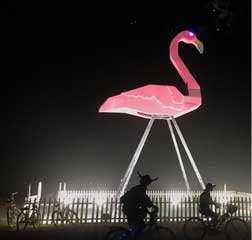EN_ BURNING MAN: A Guiding Light for Participatory Community Design
image from the author
Black Rock City is an ephemeral community (Burning Man) emerging in the landscape for nine days a year. It achieves better place attachment and interactions for its 70,000 participants than permanent landscapes in urban areas designed to serve far larger communities. Burning Man will be analyzed for its ability to inform community design in what is known as the ‘default world’- the world that exists beyond the perimeter of Burning Man. Burning Man is not confined to Black Rock City by any means, as it is first and foremost considered a cultural movement. Similar regional cultural movements exist across the globe, and although very specific to their sites, the values remain. Participants follow 10 Principles¸ the very foundation Burning Man is built upon. These Principles include: Radical Inclusion, Gifting, Decommodification, Radical Self-Reliance, Radical Self-Expression, Communal Effort, Civic Responsibility, Leaving No Trace, Participation, and Immediacy. There is considerable to be learned from the principles alone, but more interesting is the way in which they are expressed on the landscape, through regional events, and the way in which they can directly affect the idea of community design founded through civic engagement.
Supported through the community development philosophy of Randolph T. Hester, a design process framework will be generated through a reworking of participatory design. This process, rooted in the concept of ‘build your own experience’, will inform a design proposal for the University of Guelph campus, submitted to the 2018 Burning Man Global Art Grant.

FR_ BURNING MAN : un guide pour la conception communautaire participative
Black Rock City est une communauté éphémère (Burning Man) qui émerge dans le paysage neuf jours par année. Elle provoque un plus grand sentiment d’appartenance et de meilleures interactions pour ses 70 000 participants que les paysages permanents dans les régions urbaines conçus pour desservir des communautés beaucoup plus grandes. On analysera les résultats de Burning Man quant à sa capacité à éclairer le design communautaire dans ce qu’on appelle le « monde par défaut », à savoir le monde qui existe au-delà du périmètre de Burning Man. Burning Man n’est pas confiné à Black Rock City, car il s’agit avant tout d’un mouvement culturel. Des mouvements culturels régionaux similaires existent ailleurs dans le monde, et malgré leur spécificité propre à leur emplacement, les valeurs demeurent les mêmes. Les participants suivent 10 principes qui sont le fondement même de Burning Man. Ces principes comprennent l’inclusion radicale, les dons, la décommercialisation, l’autosuffisance radicale, l’auto-expression radicale, l’effort communal, la responsabilité civique, l’absence de trace, la participation et l’instantanéité. Il y a beaucoup à apprendre de ces seuls principes, mais ce qui est encore plus intéressant est la manière dont ils s’expriment sur le paysage, à travers les événements régionaux, et la façon dont ils peuvent directement influencer l’idée du design communautaire fondée sur l’engagement civique.
Inspiré par la philosophie de développement communautaire de Randolph T. Hester, un processus de conception sera généré en remaniant la conception participative. Ce processus, ancré dans le concept de « construire votre propre expérience », éclairera une proposition de design pour le campus de l’Université de Guelph qui sera soumis au programme de bourses Burning Man Global Art Grant 2018.
UPDATES / MISE A JOUR
2018.10.10 / Sarah Luce-Andreyko has completed her LACF grant which was for her work on "Burning Man" MLA thesis. It is available on the University of Guelph Atrium: http://hdl.handle.net/10214/14103.

